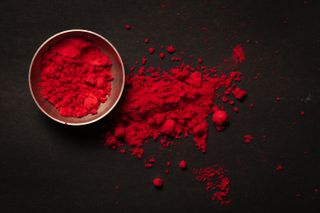
Earliest evidence of mercury poisoning in humans found in 5,000-year-old bones
The high levels of mercury were likely caused by exposure to cinnabar, used to make a bright red paint pigment.
 (Image credit: Getty Images/ziprashantzi)
(Image credit: Getty Images/ziprashantzi) The earliest evidence of mercury poisoning has been found in 5,000-year-old bones of humans buried in Spain and Portugal, according to a new study.
Exposure to the naturally occurring heavy metal may have toxic effects on the body including on the nervous, digestive and immune systems, according to The World Health Organization (WHO). That's why the WHO considers mercury one of the top 10 chemicals of "major health concern."
Today, people are most commonly exposed to some level of mercury when they eat certain fish or shellfish, though the levels are often low, according to the WHO. But how common was mercury exposure in the olden days?
Related: Shine On: Photos of dazzling mineral specimens
To figure this out, the researchers analyzed human bones collected from 23 different archaeological sites, which included pits and caves, across Spain and Portugal. The bones belonged to 370 individuals who lived in various time periods across a span of 5,000 years.
Analysis of some of the bones, mainly the humerus, the arm bone between the shoulder and the elbow, revealed unusually high levels of mercury, levels that would not have been caused by diet or by decomposition after death.
The researchers detected mercury levels of up to 400 parts per million in some of the remains, which is much higher than the 1 or 2 ppm that the WHO deems normal levels in human hair, according to a statement.
The researchers say the unusually high levels of mercury were likely caused by exposure to cinnabar, a toxic mercury sulfide mineral that, when ground into a fine powder, has a bright red color and has been historically used to produce paint pigments, according to the statement. In fact, one of the largest cinnabar mines in the world is in Almadén, Spain.
People started exploiting Almadén's cinnabar trove in the Neolithic period, around 7,000 years ago, according to the statement. The highest levels of mercury were in the remains that dated back to around 2900 B.C. to 2300 B.C., or the late Neolithic to the middle Copper Age (which was a transition between the Neolithic and Bronze Age).
RELATED CONTENT—27 oddest medical case reports
—The strangest medical conditions
—Amazing photos: The little things in life
At this time, cinnabar had become a highly symbolic, probably sacred substance, "which was sought after, traded and extensively used in a variety of rituals and social practices," the authors wrote in the study, published Oct. 13 in the International Journal of Osteoarchaeology.
In tombs dating back to this time period found in southern Portugal and Andalusia, cinnabar powder was used to paint chambers, decorate figurines and even spread over the dead. It's possible that people could have accidentally, or deliberately for reasons related to rituals, inhaled or consumed large amounts of mercury-filled cinnabar, according to the statement.
By the end of the Copper Age and start of the Bronze Age, or around 2200 B.C., the use of cinnabar decreased significantly, according to the study.
Originally published on Live Science.
 Yasemin Saplakoglu Staff Writer
Yasemin Saplakoglu Staff Writer Yasemin is a staff writer at Live Science, covering health, neuroscience and biology. Her work has appeared in Scientific American, Science and the San Jose Mercury News. She has a bachelor's degree in biomedical engineering from the University of Connecticut and a graduate certificate in science communication from the University of California, Santa Cruz.
window._taboola = window._taboola || []; var screenWidth = window.screen.width; function taboola_is_device(device) { if ((! device) || device === null || (typeof device) === 'undefined') return true if (device === 'amp') return false if (device === 'desktop' && screenWidth >= 700) return true if (device === 'mobile' && screenWidth < 700) return true return false } (function(){ var suitableDevice = taboola_is_device("desktop"); var suitablePlacement = !("Mid Article".includes('Mid Article') && "") && !("Mid Article".includes('Mid Article') && window.FUTR && window.FUTR.Kiosq && window.FUTR.Kiosq.hasBarrier); if (suitableDevice && suitablePlacement) { window._taboola.push({ mode: "thumbnails-a-mid", container: "desktop-taboola-mid-article", placement: "Mid Article", target_type: "mix" }); } })(); (function(){ var suitableDevice = taboola_is_device("mobile"); var suitablePlacement = !("Mid Article".includes('Mid Article') && "") && !("Mid Article".includes('Mid Article') && window.FUTR && window.FUTR.Kiosq && window.FUTR.Kiosq.hasBarrier); if (suitableDevice && suitablePlacement) { window._taboola.push({ mode: "thumbnails-a-mid", container: "mobile-taboola-mid-article", placement: "Mid Article", target_type: "mix" }); } })(); (function(){ var suitableDevice = taboola_is_device("desktop"); var suitablePlacement = !("Below Article Thumbnails".includes('Mid Article') && "") && !("Below Article Thumbnails".includes('Mid Article') && window.FUTR && window.FUTR.Kiosq && window.FUTR.Kiosq.hasBarrier); if (suitableDevice && suitablePlacement) { window._taboola.push({ mode: "thumbnails-f", container: "taboola-below-article-thumbnails", placement: "Below Article Thumbnails", target_type: "mix" }); } })(); (function(){ var suitableDevice = taboola_is_device("mobile"); var suitablePlacement = !("Mobile Below Article Thumbnails".includes('Mid Article') && "") && !("Mobile Below Article Thumbnails".includes('Mid Article') && window.FUTR && window.FUTR.Kiosq && window.FUTR.Kiosq.hasBarrier); if (suitableDevice && suitablePlacement) { window._taboola.push({ mode: "thumbnails-g", container: "taboola-mobile-below-article-thumbnails", placement: "Mobile Below Article Thumbnails", target_type: "mix" }); } })(); (function(){ var suitableDevice = taboola_is_device("amp"); var suitablePlacement = !("below-main-column".includes('Mid Article') && "") && !("below-main-column".includes('Mid Article') && window.FUTR && window.FUTR.Kiosq && window.FUTR.Kiosq.hasBarrier); if (suitableDevice && suitablePlacement) { window._taboola.push({ mode: "thumbnails-a", container: "", placement: "below-main-column", target_type: "" }); } })(); (function(){ var delay = 0; window.setTimeout(function() { window._taboola.push({flush: true}); }, delay); })();AP by OMG
Asian-Promotions.com |
Buy More, Pay Less | Anywhere in Asia
Shop Smarter on AP Today | FREE Product Samples, Latest
Discounts, Deals, Coupon Codes & Promotions | Direct Brand Updates every
second | Every Shopper’s Dream!
Asian-Promotions.com or AP lets you buy more and pay less anywhere in Asia. Shop Smarter on AP Today. Sign-up for FREE Product Samples, Latest Discounts, Deals, Coupon Codes & Promotions. With Direct Brand Updates every second, AP is Every Shopper’s Dream come true! Stretch your dollar now with AP. Start saving today!
Originally posted on: https://www.livescience.com/earliest-evidence-mercury-poisoning